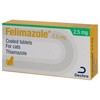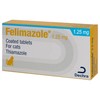Felimazole
Felimazole Coated Tablets are for the stabilisation of hyperthyroidism in cats prior to surgical removal of the thyroid gland. It can also be used for the long-term treatment of feline hyperthyroidism.
Felimazole tablets are red, pink, or orange sugar-coated biconvex tablets that are approximately 5.5mm in diameter.
Felimazole 2.5mg Coated Tablets for Cats
£0.26Felimazole 2.5mg Coated Tablets are indicated for the stabilisation of hyperthyroidism in cats prior to surgical thyroidectomy. Felimazole can also be used the for the long-term treatment...[More info]
Felimazole 5mg Coated Tablets for Cats
£0.38Felimazole 5mg Coated Tablets are indicated for the stabilisation of hyperthyroidism in cats prior to surgical thyroidectomy. Felimazole can also be used the for the long-term treatment of...[More info]
Felimazole 1.25mg Coated Tablets for Cats
£0.16Felimazole 1.25mg Coated Tablets are indicated for the stabilisation of hyperthyroidism in cats prior to surgical thyroidectomy. Felimazole can also be used the for the long-term treatment...[More info]
Contraindications
Do not use in cats suffering from systemic disease such as primary liver disease or diabetes mellitus.
Do not use in cats showing signs of autoimmune disease.
Do not use in animals with disorders of white blood cells, such as neutropenia and lymphopenia.
Do not use in animals with platelet disorders and coagulopathies (particularly thrombocytopenia).
Do not use in cases of hypersensitivity to thiamazole or the excipient, polyethylene glycol.
Do not use in pregnant or lactating females.
Please refer to Use during pregnancy and lactation.
Special precautions for use in animals
If more than 10 mg per day is required animals should be monitored particularly carefully.
Use of the product in cats with renal dysfunction should be subject to careful risk:benefit assessment by the clinician. Due to the effect thiamazole can have on reducing the glomerular filtration rate, the effect of therapy on renal function should be monitored closely as deterioration of an underlying condition may occur.
Haematology must be monitored due to risk of leucopenia or haemolytic anaemia.
Any animal that suddenly appears unwell during therapy, particularly if they are febrile, should have a blood sample taken for routine haematology and biochemistry. Neutropenic animals (neutrophil counts <2.5 x 109/l) should be treated with prophylactic bactericidal antibacterial drugs and supportive therapy.
As thiamazole can cause haemoconcentration, cats should always have access to drinking water.
Please refer to Amounts to be administered and administration route for monitoring instructions.
Special precautions to be taken by the person administering the veterinary medicinal product to animals
Wash hands after use.
In the case of accidental ingestion, seek medical advice immediately and show the package insert or the label to the physician. Thiamazole may cause vomiting, epigastric distress, headache, fever, arthralgia, pruritus and pancytopaenia. Treatment is symptomatic.
Wash hands with soap and water after handling litter used by treated animals.
Do not eat, drink or smoke while handling the tablet or used litter.
Do not handle this product if you are allergic to anti-thyroid products. If allergic symptoms develop, such as a skin rash, swelling of the face, lips or eyes or difficulty in breathing, you should seek medical attention immediately and show the package leaflet or label to the doctor.
Do not break or crush tablets.
As thiamazole is a suspected human teratogen, women of child-bearing age and pregnant women should wear gloves when handling litter of treated cats. Pregnant women should wear gloves when handling the product.
Adverse reactions
Adverse reactions have been reported following long term control of hyperthyroidism. In many cases, signs may be mild and transitory and not a reason for withdrawal of treatment. The more serious effects are mainly reversible when medication is stopped.
Adverse reactions are uncommon. The most common clinical side effects that are reported include vomiting, inappetance/anorexia, weight loss, lethargy, severe pruritus and excoriations of the head and neck, bleeding diathesis and icterus associated with hepatopathy, and haematological abnormalities (eosinophilia, lymphocytosis, neutropenia, lymphopenia, slight leucopenia, agranulocytosis, thrombocytopenia or haemolytic anaemia). These side effects resolve within 7-45 days after cessation of thiamazole therapy.
Possible immunological side effects include anaemia, with rare side effects including thrombocytopenia and serum anti-nuclear antibodies, and, very rarely, lymphadenopathy can occur. Treatment should be stopped immediately and alternative therapy considered following a suitable period for recovery.
Following long-term treatment with thiamazole in rodents, an increased risk of neoplasia in the thyroid gland has been shown to occur, but no evidence is available in cats.
The frequency of adverse reactions is defined using the following convention:
- very common (more than 1 in 10 animals treated displaying adverse reaction(s))
- common (more than 1 but less than 10 animals in 100 animals treated)
- uncommon (more than 1 but less than 10 animals in 1,000 animals treated)
- rare (more than 1 but less than 10 animals in 10,000 animals treated)
- very rare (less than 1 animal in 10,000 animals treated, including isolated reports).
Use during pregnancy and lactation
Laboratory studies in rats and mice have shown evidence of teratogenic and embryotoxic effects of thiamazole. The safety of the product was not assessed in pregnant or lactating cats. Do not use in pregnant or lactating females.
Interactions
Concurrent treatment with phenobarbital may reduce the clinical efficacy of thiamazole.
Thiamazole is known to reduce the hepatic oxidation of benzimidazole wormers and may lead to increases in their plasma concentrations when given concurrently.
Thiamazole is immunomodulatory, therefore this should be taken into account when considering vaccination programmes.
Amounts to be administered and administration route
For oral administration only.
For the stabilisation of feline hyperthyroidism prior to surgical thyroidectomy and for the long term treatment of feline hyperthyroidism, the recommended starting dose is 5 mg per day.
Wherever possible, the total daily dose should be divided into two and administered morning and evening. Tablets should not be split.
If, for reasons of compliance, once daily dosing with a 5 mg tablet is preferable, then this is acceptable although the 2.5 mg tablet given twice daily may be more efficacious in the short term. The 5 mg tablet is also suitable for cats requiring higher dose rates.
1.25 mg tablets are intended for use in cats that require particularly small doses of thiamazole, and to assist with dosage adjustments.
Haematology, biochemistry and serum total T4 should be assessed before initiating treatment and after 3 weeks, 6 weeks, 10 weeks, 20 weeks, and thereafter every 3 months. At each of the recommended monitoring intervals, the dose should be titrated to effect according to the total T4 and to clinical response to treatment. Dose adjustments should be made in increments of 2.5 mg and the aim should be to achieve the lowest possible dose rate.
If more than 10 mg per day is required animals should be monitored particularly carefully. The dose administered should not exceed 20 mg/day.
For long term treatment of hyperthyroidism the animal should be treated for life.
Overdose
In tolerance studies in young healthy cats, the following dose-related clinical signs occurred at doses of up to 30 mg/animal/day: anorexia, vomiting, lethargy, pruritus and haematological and biochemical abnormalities such as neutropenia, lymphopenia, reduced serum potassium and phosphorus levels, increased magnesium and creatinine levels and the occurrence of anti-nuclear antibodies. At a dose of 30 mg/day some cats showed signs of haemolytic anaemia and severe clinical deterioration. Some of these signs may also occur in hyperthyroid cats treated at doses of up to 20 mg per day.
Excessive doses in hyperthyroid cats may result in signs of hypothyroidism. This is however unlikely, as hypothyroidism is usually corrected by negative feedback mechanisms. Please refer to Adverse reactions.
If overdosage occurs, stop treatment and give symptomatic and supportive care.


